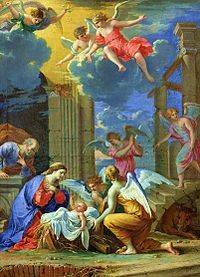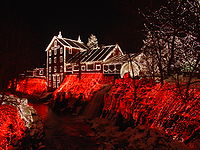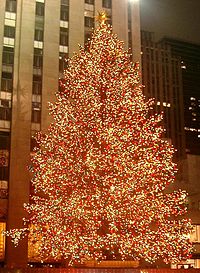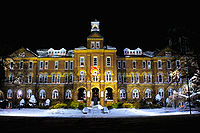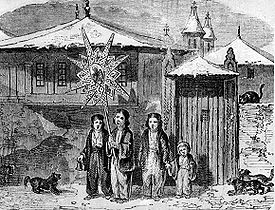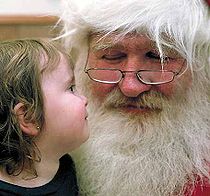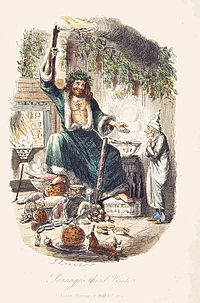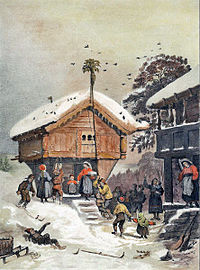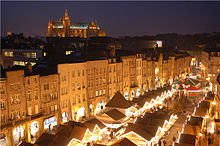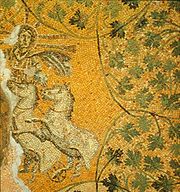- Christmas
-
"Christmas Day" redirects here. For other uses, see Christmas (disambiguation) and Christmas Day (disambiguation).
Christmas 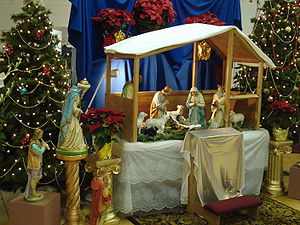
Christmas decorations on display.Also called Christ's Mass
Nativity
Noel
Feast of the NativityObserved by Christians
Many non-Christians[1]Type Christian, cultural Significance Traditional birthday of Jesus Date December 25 (alternatively January 6, 7 or 19)[2][3][4] (see below) Observances Gift giving, church services, family and other social gatherings, symbolic decorating Related to Annunciation, Advent, Epiphany, Baptism of the Lord Christmas or Christmas Day is a holiday[5][6][7] generally observed on December 25 (with alternative days of January 6, 7 and 19[2]) to commemorate the birth of Jesus, the central figure of Christianity.[8][9] The exact birthday of Jesus is not known, and historians place his year of birth some time between 7 BC and 2 BC. Narratives of his birth are included in two of the Canonical gospels in the New Testament of the Bible.
The date of Christmas may have initially been chosen to correspond with either the day exactly nine months after Christians believe Jesus to have been conceived,[10] the date of the Roman winter solstice,[11] or one of various ancient winter festivals.[10][12] Christmas is central to the Christmas and holiday season, and in Christianity marks the beginning of the larger season of Christmastide, which lasts twelve days.[13]
Although nominally a Christian holiday, Christmas is celebrated by an increasing number of non-Christians worldwide,[1][14][15] and many of its popular celebratory customs have pre-Christian or secular themes and origins. Popular modern customs of the holiday include gift-giving, music, an exchange of Christmas cards, church celebrations, a special meal, and the display of various decorations; including Christmas trees, lights, garlands, mistletoe, nativity scenes, and holly. In addition, several figures, known as Saint Nicholas, Father Christmas, and Santa Claus, among other names, are associated with bringing gifts to children during the Christmas season.[16]
Because gift-giving and many other aspects of the Christmas festival involve heightened economic activity among both Christians and non-Christians, the holiday has become a significant event and a key sales period for retailers and businesses. The economic impact of Christmas is a factor that has grown steadily over the past few centuries in many regions of the world.
Contents
Etymology
The word Christmas originated as a compound meaning "Christ's Mass". It is derived from the Middle English Christemasse and Old English Cristes mæsse, a phrase first recorded in 1038.[9] "Cristes" is from Greek Χριστός Christos and "mæsse" is from Latin missa (the holy mass).
Celebration
Christmas Day is celebrated as a major festival and public holiday in countries around the world, including many whose populations are mostly non-Christian. In some non-Christian countries, periods of former colonial rule introduced the celebration (e.g. Hong Kong); in others, Christian minorities or foreign cultural influences have led populations to observe the holiday. Countries such as Japan and Korea, where Christmas is popular despite there being only a small number of Christians, have adopted many of the secular aspects of Christmas, such as gift-giving, decorations and Christmas trees.
Notable countries in which Christmas is not a formal public holiday include People's Republic of China, (excepting Hong Kong and Macao), Japan, Saudi Arabia, Algeria, Thailand, Nepal, Iran, Turkey and North Korea. Christmas celebrations around the world can vary markedly in form, reflecting differing cultural and national traditions.
Among countries with a strong Christian tradition, a variety of Christmas celebrations have developed that incorporate regional and local cultures. For Christians, participating in a religious service plays an important part in the recognition of the season. Christmas, along with Easter, is the period of highest annual church attendance.
In Catholic countries, the people hold religious processions or parades in the days preceding Christmas. In other countries, secular processions or parades featuring Santa Claus and other seasonal figures are often held. Family reunions and the exchange of gifts are a widespread feature of the season. Gift giving takes place on Christmas Day in most countries. Others practice gift giving on December 6, Saint Nicholas Day, and January 6, Epiphany.
Date of celebration
For centuries, Christian writers accepted that Christmas was the actual date on which Jesus was born.[17] John Chrysostom preached a sermon in Antioch c. 386 which established the date of Christmas as December 25 on the Julian calendar since the conception of Jesus (Luke 1:26) had been announced during the sixth month of Elisabeth's pregnancy with John the Baptist (Luke 1:10-13) as dated from the duties Zacharias performed on the Day of Atonement during the seventh month of the Hebrew calendar Ethanim or Tishri (Lev. 16:29, 1 Kings 8:2) which falls in September–October.[9]
In the early 18th century, scholars began proposing alternative explanations. Isaac Newton argued that the date of Christmas was selected to correspond with the winter solstice,[11] which the Romans called bruma and celebrated on December 25.[18] In 1743, German Protestant Paul Ernst Jablonski argued Christmas was placed on December 25 to correspond with the Roman solar holiday Dies Natalis Solis Invicti and was therefore a "paganization" that debased the true church.[12] In 1889, Louis Duchesne proposed that the date of Christmas was calculated as nine months after the Annunciation, the traditional date of the conception of Jesus.[19][10]
In the early 4th century, the church calendar contained Christmas on December 25 and other holidays placed on solar dates: "It is cosmic symbolism...which inspired the Church leadership in Rome to elect the winter solstice, December 25, as the birthday of Christ, and the summer solstice as that of John the Baptist, supplemented by the equinoxes as their respective dates of conception. While they were aware that pagans called this day the 'birthday' of Sol Invictus, this did not concern them and it did not play any role in their choice of date for Christmas," according to modern scholar S.E. Hijmans.[20]
However, today, whether or not the birth date of Jesus is on December 25 is not considered to be an important issue among mainstream Christian denominations;[21][22][23] rather, celebrating the coming of God into the world in the form of man to atone for the sins of humanity is considered to be the primary meaning of Christmas.[21][22][23]
Using the Julian calendar
Eastern Orthodox national churches, including those of Russia, Georgia, Ukraine, Macedonia, Montenegro, Serbia and the Greek Patriarchate of Jerusalem mark feasts using the older Julian calendar. December 25 on the Julian calendar currently corresponds to January 7 on the internationally-used Gregorian calendar. However, other Orthodox Christians, such as the churches of Greece, Romania, Antioch, Alexandria, Albania, Finland and the Orthodox Church in America, among others, began using the Revised Julian calendar in the early 20th century, which corresponds exactly to the Gregorian calendar.[4]
These Orthodox Churches celebrate Christmas on the same day as Western Christianity. Oriental Orthodox churches also use their own calendars, which are generally similar to the Julian calendar. The Armenian Apostolic Church celebrates the nativity in combination with the Feast of the Epiphany on January 6. Armenian churches customarily use the Gregorian calendar, but some use the Julian calendar and thus celebrate Christmas Day on January 19, and Christmas Eve on January 18 (according to the Gregorian calendar).[4]
Commemorating Jesus’ birth
Christians celebrate the birth of Jesus to the Virgin Mary as a fulfillment of the Old Testament's Messianic prophecy.[24] The Bible contains two accounts which describe the events surrounding Jesus' birth. Depending on one's perspective, these accounts either differ from each other or tell two versions of the same story [25] [26][27][28] These biblical accounts are found in the Gospel of Matthew, namely Matthew 1:18, and the Gospel of Luke, specifically Luke 1:26 and 2:40. According to these accounts, Jesus was born to Mary, assisted by her husband Joseph, in the city of Bethlehem.
According to popular tradition, the birth took place in a stable, surrounded by farm animals, though neither the stable nor the animals are specifically mentioned in the Biblical accounts. However, a manger is mentioned in Luke 2:7, where it states, "She wrapped him in cloths and placed him in a manger, because there was no room for them in the inn." Early iconographic representations of the nativity placed the animals and manger within a cave (located, according to tradition, under the Church of the Nativity in Bethlehem). Shepherds from the fields surrounding Bethlehem were told of the birth by an angel, and were the first to see the child.[29]
The Gospel of Matthew also describes a visit by several Magi, or astrologers, who bring gifts of gold, frankincense, and myrrh to the infant Jesus. The visitors were said to be following a mysterious star, commonly known as the Star of Bethlehem, believing it to announce the birth of a king of the Jews.[30] The commemoration of this visit, the Feast of Epiphany celebrated on January 6, is the formal end of the Christmas season in some churches.
 Anbetung der Hirten (Adoration of the Shepherds) (c. 1500–10), by Italian painter Giorgio da Castelfranco
Anbetung der Hirten (Adoration of the Shepherds) (c. 1500–10), by Italian painter Giorgio da Castelfranco
Christians celebrate Christmas in various ways. In addition to this day being one of the most important and popular for the attendance of church services, there are other devotions and popular traditions. In some Christian denominations, children re-enact the events of the Nativity with animals to portray the event with more realism or sing carols that reference the event. Some Christians also display a small re-creation of the Nativity, known as a Nativity scene or crèche, in their homes, using figurines to portray the key characters of the event. Prior to Christmas Day, the Eastern Orthodox Church practices the 40-day Nativity Fast in anticipation of the birth of Jesus, while much of Western Christianity celebrates four weeks of Advent. The final preparations for Christmas are made on Christmas Eve.
A long artistic tradition has grown of producing painted depictions of the nativity in art. Nativity scenes are traditionally set in a barn or stable and include Mary, Joseph, the child Jesus, angels, shepherds and the Three Wise Men: Balthazar, Melchior, and Caspar, who are said to have followed a star, known as the Star of Bethlehem, and arrived after his birth.[31]
Decorations
The practice of putting up special decorations at Christmas has a long history. From pre-Christian times, people in the Roman Empire brought branches from evergreen plants indoors in the winter. Decorating with greenery was also part of Jewish tradition : "Now on the first day you shall take for yourselves the foliage of beautiful trees, palm branches and boughs of leafy trees and willows of the brook, and you shall rejoice before the LORD your God for seven days. " (Leviticus 23:40)
Christians incorporated such customs in their developing practices. In the 15th century, it was recorded that in London it was the custom at Christmas for every house and all the parish churches to be "decked with holm, ivy, bays, and whatsoever the season of the year afforded to be green".[32] The heart-shaped leaves of ivy were said to symbolize the coming to earth of Jesus, while holly was seen as protection against pagans and witches, its thorns and red berries held to represent the Crown of Thorns worn by Jesus at the crucifixion and the blood he shed.[33][34]
Nativity scenes are known from 10th-century Rome. They were popularised by Saint Francis of Asissi from 1223, quickly spreading across Europe.[35] Different types of decorations developed across the Christian world, dependent on local tradition and available resources. The first commercially produced decorations appeared in Germany in the 1860s, inspired by paper chains made by children.[36] In countries where a representation of the Nativity Scene is very popular, people are encouraged to compete and create the most original or realistic ones. Within some families, the pieces used to make the representation are considered a valuable family heirloom.
The traditional colors of Christmas are green and red.[37] White, silver and gold are also popular. Red symbolizes the blood of Jesus, which was shed in his crucifixion, while green symbolizes eternal life, and in particular the evergreen tree, which does not lose its leaves in the winter.[34][37]
The Christmas tree is considered by some as Christianisation of pagan tradition and ritual surrounding the Winter Solstice, which included the use of evergreen boughs, and an adaptation of pagan tree worship.[38] The English language phrase "Christmas tree" is first recorded in 1835[39] and represents an importation from the German language. The modern Christmas tree tradition is believed to have begun in Germany in the 18th century[38] though many argue that Martin Luther began the tradition in the 16th century.[40][41]
From Germany the custom was introduced to Britain, first via Queen Charlotte, wife of George III, and then more successfully by Prince Albert during the reign of Queen Victoria. By 1841 the Christmas tree had become even more widespread throughout Britain.[42] By the 1870s, people in the United States had adopted the custom of putting up a Christmas tree.[43] Christmas trees may be decorated with lights and ornaments.
Since the 19th century, the poinsettia, a native plant from Mexico, has been associated with Christmas. Other popular holiday plants include holly, mistletoe, red amaryllis, and Christmas cactus. Along with a Christmas tree, the interior of a home may be decorated with these plants, along with garlands and evergreen foliage. The display of Christmas villages has also become a tradition in many homes during this season. The outside of houses may be decorated with lights and sometimes with illuminated sleighs, snowmen, and other Christmas figures.
Other traditional decorations include bells, candles, candy canes, stockings, wreaths, and angels. Both the displaying of wreaths and candles in each window are a more traditional Christmas display. The concentric assortment of leaves, usually from an evergreen, make up Christmas wreaths and are designed to prepare Christians for the Advent season. Candles in each window are meant to demonstrate the fact that Christians believe that Jesus Christ is the ultimate light of the world.[44] Both of these antiquated, more subdued, Christmas displays are seen in the image to the right of Saint Anselm College.
Christmas lights and banners may be hung along streets, music played from speakers, and Christmas trees placed in prominent places.[45] It is common in many parts of the world for town squares and consumer shopping areas to sponsor and display decorations. Rolls of brightly colored paper with secular or religious Christmas motifs are manufactured for the purpose of wrapping gifts.
In some countries, Christmas decorations are traditionally taken down on Twelfth Night, the evening of January 5.
Music and carols
The first specifically Christmas hymns that we know of appear in 4th century Rome. Latin hymns such as Veni redemptor gentium, written by Ambrose, Archbishop of Milan, were austere statements of the theological doctrine of the Incarnation in opposition to Arianism. Corde natus ex Parentis (Of the Father's love begotten) by the Spanish poet Prudentius (d. 413) is still sung in some churches today.[46]
In the 9th and 10th centuries, the Christmas "Sequence" or "Prose" was introduced in North European monasteries, developing under Bernard of Clairvaux into a sequence of rhymed stanzas. In the 12th century the Parisian monk Adam of St. Victor began to derive music from popular songs, introducing something closer to the traditional Christmas carol.
By the 13th century, in France, Germany, and particularly, Italy, under the influence of Francis of Asissi, a strong tradition of popular Christmas songs in the native language developed.[47] Christmas carols in English first appear in a 1426 work of John Awdlay, a Shropshire chaplain, who lists twenty-five "caroles of Cristemas", probably sung by groups of wassailers, who went from house to house.[48]
The songs we know specifically as carols were originally communal folk songs sung during celebrations such as "harvest tide" as well as Christmas. It was only later that carols began to be sung in church. Traditionally, carols have often been based on medieval chord patterns, and it is this that gives them their uniquely characteristic musical sound. Some carols like "Personent hodie", "Good King Wenceslas", and "The Holly and the Ivy" can be traced directly back to the Middle Ages. They are among the oldest musical compositions still regularly sung. Adeste Fidelis (O Come all ye faithful) appears in its current form in the mid-18th century, although the words may have originated in the 13th century.
Singing of carols initially suffered a decline in popularity after the Protestant Reformation in northern Europe, although some Reformers, like Martin Luther, wrote carols and encouraged their use in worship. Carols largely survived in rural communities until the revival of interest in popular songs in the 19th century. The 18th century English reformer Charles Wesley understood the importance of music to worship. In addition to setting many psalms to melodies, which were influential in the Great Awakening in the United States, he wrote texts for at least three Christmas carols. The best known was originally entitled "Hark! How All the Welkin Rings", later renamed "Hark! the Herald Angels Sing".[49]
Felix Mendelssohn wrote a melody adapted to fit Wesley's words. In Austria in 1818 Mohr and Gruber made a major addition to the genre when they composed "Silent Night" for the St. Nicholas Church, Oberndorf. William B. Sandys' Christmas Carols Ancient and Modern (1833) contained the first appearance in print of many now-classic English carols, and contributed to the mid-Victorian revival of the festival.[50]
Completely secular Christmas seasonal songs emerged in the late 18th century. "Deck The Halls" dates from 1784, and the American, "Jingle Bells" was copyrighted in 1857. In the 19th and 20th century, African American spirituals and songs about Christmas, based in their tradition of spirituals, became more widely known. An increasing number of seasonal holidays songs were commercially produced in the 20th century, including jazz and blues variations. In addition, there was a revival of interest in early music, from groups singing folk music, such as The Revels, to performers of early medieval and classical music.
Food
A special Christmas family meal is traditionally an important part of the holiday's celebration, and the food that is served varies greatly from country to country. Some regions, such as Sicily, have special meals for Christmas Eve, when 12 kinds of fish are served. In England and countries influenced by its traditions, a standard Christmas meal includes turkey or goose, meat, gravy, potatoes, vegetables, sometimes bread and cider. Special desserts are also prepared, such as Christmas pudding, mince pies and fruit cake.[51][52]
In Poland and other parts of eastern Europe and Scandinavia, fish often is used for the traditional main course, but richer meat such as lamb is increasingly served. In Germany, France and Austria, goose and pork are favored. Beef, ham and chicken in various recipes are popular throughout the world. The Maltese traditionally serve Imbuljuta tal-Qastan,[53] a chocolate and chestnuts beverage, after Midnight Mass and throughout the Christmas season. Slovaks prepare the traditional Christmas bread potica, bûche de Noël in France, panettone in Italy, and elaborate tarts and cakes. The eating of sweets and chocolates has become popular worldwide, and sweeter Christmas delicacies include the German stollen, marzipan cake or candy, and Jamaican rum fruit cake. As one of the few fruits traditionally available to northern countries in winter, oranges have been long associated with special Christmas foods.
Cards
Christmas cards are illustrated messages of greeting exchanged between friends and family members during the weeks preceding Christmas Day. The traditional greeting reads "wishing you a Merry Christmas and a Happy New Year", much like that of the first commercial Christmas card, produced by Sir Henry Cole in London in 1843.[54] The custom of sending them has become popular among a wide cross-section of people with the emergence of the modern trend towards exchanging E-cards.
Christmas cards are purchased in considerable quantities, and feature artwork, commercially designed and relevant to the season. The content of the design might relate directly to the Christmas narrative with depictions of the Nativity of Jesus, or Christian symbols such as the Star of Bethlehem, or a white dove which can represent both the Holy Spirit and Peace on Earth. Other Christmas cards are more secular and can depict Christmas traditions, mythical figures such as Santa Claus, objects directly associated with Christmas such as candles, holly and baubles, or a variety of images associated with the season, such as Christmastime activities, snow scenes and the wildlife of the northern winter. There are even humorous cards and genres depicting nostalgic scenes of the past such as crinolined shoppers in idealized 19th century streetscapes.
Some prefer cards with a poem, prayer or Biblical verse; while others distance themselves from religion with an all-inclusive "Season's greetings".
Stamps
A number of nations have issued commemorative stamps at Christmastime. Postal customers will often use these stamps to mail Christmas cards, and they are popular with philatelists. These stamps are regular postage stamps, unlike Christmas seals, and are valid for postage year-round. They usually go on sale some time between early October and early December, and are printed in considerable quantities.
In 1898 a Canadian stamp was issued to mark the inauguration of the Imperial Penny Postage rate. The stamp features a map of the globe and bears an inscription "XMAS 1898" at the bottom. In 1937, Austria issued two "Christmas greeting stamps" featuring a rose and the signs of the zodiac. In 1939, Brazil issued four semi-postal stamps with designs featuring the three kings and a star of Bethlehem, an angel and child, the Southern Cross and a child, and a mother and child.
Both the US Postal Service and the Royal Mail regularly issue Christmas-themed stamps each year.
Gift giving
The exchanging of gifts is one of the core aspects of the modern Christmas celebration, making the Christmas season the most profitable time of year for retailers and businesses throughout the world. Gift giving was common in the Roman celebration of Saturnalia, an ancient festival which took place in late December and may have influenced Christmas customs.[55] Christmas gift giving was banned by the Catholic Church in the Middle Ages due to its suspected pagan origins.[55] It was later rationalized by the Church on the basis that it associated St. Nicholas with Christmas, and that gifts of gold, frankincense and myrrh were given to the infant Jesus by the Biblical Magi.
Legendary gift-bringing figures
A number of figures of both Christian and mythical origin have been associated with Christmas and the seasonal giving of gifts. Among these are Father Christmas, also known as Santa Claus, Père Noël, and the Weihnachtsmann; Saint Nicholas or Sinterklaas; the Christkind; Kris Kringle; Joulupukki; Babbo Natale; Saint Basil; and Father Frost.
The most famous and pervasive of these figures in modern celebration worldwide is Santa Claus, a mythical gift bringer, dressed in red, whose origins have diverse sources. The name Santa Claus can be traced back to the Dutch Sinterklaas, which means simply Saint Nicholas. Nicholas was Bishop of Myra, in modern day Turkey, during the 4th century. Among other saintly attributes, he was noted for the care of Children, generosity, and the giving of gifts. His feast on the 6th of December came to be celebrated in many countries with the giving of gifts.[56]
Saint Nicholas traditionally appeared in bishop's attire, accompanied by helpers, inquiring about the behaviour of children during the past year before deciding whether they deserved a gift or not. By the 13th century, Saint Nicholas was well known in the Netherlands, and the practice of gift-giving in his name spread to other parts of central and southern Europe. At the Reformation in 16th–17th century Europe, many Protestants changed the gift bringer to the Christ Child or Christkindl, corrupted in English to Kris Kringle, and the date of giving gifts changed from December the 6th to Christmas Eve.[56]
The modern popular image of Santa Claus, however, was created in the United States, and in particular in New York. The transformation was accomplished with the aid of notable contributors including Washington Irving and the German-American cartoonist Thomas Nast (1840–1902). Following the American Revolutionary War, some of the inhabitants of New York City sought out symbols of the city's non-English past. New York had originally been established as the Dutch colonial town of New Amsterdam and the Dutch Sinterklaas tradition was reinvented as Saint Nicholas.[57]
In 1809, the New-York Historical Society convened and retroactively named Sancte Claus the patron saint of Nieuw Amsterdam, the Dutch name for New York City.[58] At his first American appearance in 1810, Santa Claus was drawn in bishops' robes. However as new artists took over, Santa Claus developed more secular attire.[59] Nast drew a new image of "Santa Claus" annually, beginning in 1863. By the 1880s, Nast's Santa had evolved into the robed, fur clad, form we now recognize, perhaps based on the English figure of Father Christmas. The image was standardized by advertisers in the 1920s.[60]
Father Christmas, a jolly, well nourished, bearded man who typified the spirit of good cheer at Christmas, predates the Santa Claus character. He is first recorded in early 17th century England, but was associated with holiday merrymaking and drunkenness rather than the bringing of gifts.[39] In Victorian Britain, his image was remade to match that of Santa. The French Père Noël evolved along similar lines, eventually adopting the Santa image. In Italy, Babbo Natale acts as Santa Claus, while La Befana is the bringer of gifts and arrives on the eve of the Epiphany. It is said that La Befana set out to bring the baby Jesus gifts, but got lost along the way. Now, she brings gifts to all children. In some cultures Santa Claus is accompanied by Knecht Ruprecht, or Black Peter. In other versions, elves make the toys. His wife is referred to as Mrs. Claus.
There has been some opposition to the narrative of the American evolution of Saint Nicholas into the modern Santa. It has been claimed that the Saint Nicholas Society was not founded until 1835, almost half a century after the end of the American War of Independence.[61] Moreover, a study of the "children's books, periodicals and journals" of New Amsterdam by Charles Jones revealed no references to Saint Nicholas or Sinterklaas.[62] However, not all scholars agree with Jones's findings, which he reiterated in a booklength study in 1978;[63] Howard G. Hageman, of New Brunswick Theological Seminary, maintains that the tradition of celebrating Sinterklaas in New York was alive and well from the early settlement of the Hudson Valley on.[64]
Current tradition in several Latin American countries (such as Venezuela and Colombia) holds that while Santa makes the toys, he then gives them to the Baby Jesus, who is the one who actually delivers them to the children's homes, a reconciliation between traditional religious beliefs and the iconography of Santa Claus imported from the United States.
In South Tyrol (Italy), Austria, Czech Republic, Southern Germany, Hungary, Liechtenstein, Slovakia and Switzerland, the Christkind (Ježíšek in Czech, Jézuska in Hungarian and Ježiško in Slovak) brings the presents. The German St. Nikolaus is not identical with the Weihnachtsmann (who is the German version of Santa Claus/Father Christmas). St. Nikolaus wears a bishop's dress and still brings small gifts (usually candies, nuts and fruits) on December 6 and is accompanied by Knecht Ruprecht. Although many parents around the world routinely teach their children about Santa Claus and other gift bringers, some have come to reject this practice, considering it deceptive.[65]
History
 Mosaic of Jesus as Christo Sole (Christ the Sun) in Mausoleum M in the pre-fourth-century necropolis under St Peter's Basilica in Rome.[66]
Mosaic of Jesus as Christo Sole (Christ the Sun) in Mausoleum M in the pre-fourth-century necropolis under St Peter's Basilica in Rome.[66]
Pre-Christian background
Dies Natalis Solis Invicti
Dies Natalis Solis Invicti means "the birthday of the unconquered sun".
Modern scholars have argued that the festival was placed on the date of the solstice because this was on this day that the Sun reversed its southward retreat and proved itself to be "unconquered".[citation needed] Some early Christian writers connected the rebirth of the sun to the birth of Jesus.[9] "O, how wonderfully acted Providence that on that day on which that Sun was born...Christ should be born", Cyprian wrote.[9] John Chrysostom also commented on the connection: "They call it the 'Birthday of the Unconquered'. Who indeed is so unconquered as Our Lord . . .?"[9]
Although Dies Natalis Solis Invicti has been the subject of a great deal of scholarly speculation,.[citation needed] the only ancient source for it is a single mention in the Chronography of 354, and modern Sol scholar Steven Hijmans argues that there is no evidence that the celebration precedes that of Christmas:[20] "[W]hile the winter solstice on or around the 25th of December was well established in the Roman imperial calendar, there is no evidence that a religious celebration of Sol on that day antedated the celebration of Christmas, and none that indicates that Aurelian had a hand in its institution."[20]
Winter festivals
A winter festival was the most popular festival of the year in many cultures. Reasons included the fact that less agricultural work needs to be done during the winter, as well as an expectation of better weather as spring approached.[67] Modern Christmas customs include: gift-giving and merrymaking from Roman Saturnalia; greenery, lights, and charity from the Roman New Year; and Yule logs and various foods from Germanic feasts.[68]
Pagan Scandinavia celebrated a winter festival called Yule, held in the late December to early January period.[citation needed] As Northern Europe was the last part to Christianize, its pagan traditions had a major influence on Christmas, especially Koleda,[69] which was incorporated into the Christmas carol. Scandinavians still call Christmas Jul. In English, the word Yule is synonymous with Christmas,[70] a usage first recorded in 900.
Christian feast
The New Testament does not give a date for the birth of Jesus.[9][71] Around AD 200, Clement of Alexandria wrote that a group in Egypt celebrated the nativity on 25 Pashons.[9] This corresponds to May 20.[72] Tertullian (d. 220) does not mention Christmas as a major feast day in the Church of Roman Africa.[9] However, in Chronographai, a reference work published in 221, Sextus Julius Africanus suggested that Jesus was conceived on the spring equinox, popularizing the idea that Christ was born on December 25.[73][74] The equinox was March 25 on the Roman calendar, so this implied a birth in December.[75]
In 245, the theologian Origen of Alexandria stated that, "only sinners (like Pharaoh and Herod)" celebrated their birthdays.[76] In 303, Christian writer Arnobius ridiculed the idea of celebrating the birthdays of gods. However, since Christmas does not celebrate Christ's birth "as God" but "as man", this is not evidence against Christmas being a feast at this time.[9] Moreover, the fact that the innovation rejecting Donatist Church of North Africa celebrated Christmas suggests that the feast had been established before the living memory of those who began that Church in 311.
Feast established
The earliest known reference to the date of the nativity as December 25 is found in the Chronography of 354, an illuminated manuscript compiled in Rome.[77] In the East, early Christians celebrated the birth of Christ as part of Epiphany (January 6), although this festival emphasized celebration of the baptism of Jesus.[78]
Christmas was promoted in the Christian East as part of the revival of Catholicism following the death of the pro-Arian Emperor Valens at the Battle of Adrianople in 378. The feast was introduced to Constantinople in 379, and to Antioch in about 380. The feast disappeared after Gregory of Nazianzus resigned as bishop in 381, although it was reintroduced by John Chrysostom in about 400.[9]
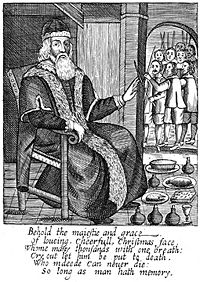 The Examination and Trial of Father Christmas, (1686), published shortly after Christmas was reinstated as a holy day in England.
The Examination and Trial of Father Christmas, (1686), published shortly after Christmas was reinstated as a holy day in England.
Middle Ages
In the Early Middle Ages, Christmas Day was overshadowed by Epiphany, which in the west focused on the visit of the magi. But the Medieval calendar was dominated by Christmas-related holidays. The forty days before Christmas became the "forty days of St. Martin" (which began on November 11, the feast of St. Martin of Tours), now known as Advent.[79] In Italy, former Saturnalian traditions were attached to Advent.[79] Around the 12th century, these traditions transferred again to the Twelve Days of Christmas (December 25 – January 5); a time that appears in the liturgical calendars as Christmastide or Twelve Holy Days.[79]
The prominence of Christmas Day increased gradually after Charlemagne was crowned Emperor on Christmas Day in 800. King Edmund the Martyr was anointed on Christmas in 855 and King William I of England was crowned on Christmas Day 1066.
By the High Middle Ages, the holiday had become so prominent that chroniclers routinely noted where various magnates celebrated Christmas. King Richard II of England hosted a Christmas feast in 1377 at which twenty-eight oxen and three hundred sheep were eaten.[79] The Yule boar was a common feature of medieval Christmas feasts. Caroling also became popular, and was originally a group of dancers who sang. The group was composed of a lead singer and a ring of dancers that provided the chorus. Various writers of the time condemned caroling as lewd, indicating that the unruly traditions of Saturnalia and Yule may have continued in this form.[79] "Misrule"—drunkenness, promiscuity, gambling—was also an important aspect of the festival. In England, gifts were exchanged on New Year's Day, and there was special Christmas ale.[79]
Christmas during the Middle Ages was a public festival that incorporated ivy, holly, and other evergreens.[80] Christmas gift-giving during the Middle Ages was usually between people with legal relationships, such as tenant and landlord.[80] The annual indulgence in eating, dancing, singing, sporting, and card playing escalated in England, and by the 17th century the Christmas season featured lavish dinners, elaborate masques and pageants. In 1607, King James I insisted that a play be acted on Christmas night and that the court indulge in games.[81] It was during the Reformation in 16th–17th century Europe that many Protestants changed the gift bringer to the Christ Child or Christkindl, and the date of giving gifts changed from December 6 to Christmas Eve.[56]
Reformation into the 19th century
Following the Protestant Reformation, groups such as the Puritans strongly condemned the celebration of Christmas, considering it a Catholic invention and the "trappings of popery" or the "rags of the Beast."[82] The Catholic Church responded by promoting the festival in a more religiously oriented form. King Charles I of England directed his noblemen and gentry to return to their landed estates in midwinter to keep up their old style Christmas generosity.[81] Following the Parliamentarian victory over Charles I during the English Civil War, England's Puritan rulers banned Christmas in 1647.[82]
Protests followed as pro-Christmas rioting broke out in several cities and for weeks Canterbury was controlled by the rioters, who decorated doorways with holly and shouted royalist slogans.[82] The book, The Vindication of Christmas (London, 1652), argued against the Puritans, and makes note of Old English Christmas traditions, dinner, roast apples on the fire, card playing, dances with "plow-boys" and "maidservants", and carol singing.[83] The Restoration of King Charles II in 1660 ended the ban, but many clergymen still disapproved of Christmas celebration. In Scotland, the Presbyterian Church of Scotland also discouraged observance of Christmas. James VI commanded its celebration in 1618, however attendance at church was scant.[84]
In Colonial America, the Puritans of New England shared radical Protestant disapproval of Christmas. Celebration was outlawed in Boston from 1659 to 1681. The ban by the Pilgrims was revoked in 1681 by English governor Sir Edmund Andros, however it was not until the mid-19th century that celebrating Christmas became fashionable in the Boston region.[85]
At the same time, Christian residents of Virginia and New York observed the holiday freely. Pennsylvania German Settlers, pre-eminently the Moravian settlers of Bethlehem, Nazareth and Lititz in Pennsylvania and the Wachovia Settlements in North Carolina, were enthusiastic celebrators of Christmas. The Moravians in Bethlehem had the first Christmas trees in America as well as the first Nativity Scenes.[86] Christmas fell out of favor in the United States after the American Revolution, when it was considered an English custom.[87] George Washington attacked Hessian (German) mercenaries on Christmas during the Battle of Trenton in 1777, Christmas being much more popular in Germany than in America at this time.
By the 1820s, sectarian tension had eased in Britain and writers, including William Winstanly, began to worry that Christmas was dying out. These writers imagined Tudor Christmas as a time of heartfelt celebration, and efforts were made to revive the holiday. In 1843, Charles Dickens wrote the novel A Christmas Carol, that helped revive the 'spirit' of Christmas and seasonal merriment.[88][89] Its instant popularity played a major role in portraying Christmas as a holiday emphasizing family, goodwill, and compassion.[90]
The Queen's Christmas tree at Windsor Castle published in the Illustrated London News, 1848, and republished in Godey's Lady's Book, Philadelphia, December 1850.
Dickens sought to construct Christmas as a family-centered festival of generosity, in contrast to the community-based and church-centered observations, the observance of which had dwindled during the late 18th century and early 19th century.[91] Superimposing his secular vision of the holiday, Dickens influenced many aspects of Christmas that are celebrated today in Western culture, such as family gatherings, seasonal food and drink, dancing, games, and a festive generosity of spirit.[92] A prominent phrase from the tale, 'Merry Christmas', was popularized following the appearance of the story.[93]
The term Scrooge became a synonym for miser, with 'Bah! Humbug!' dismissive of the festive spirit.[94] In 1843, the first commercial Christmas card was produced by Sir Henry Cole.[95] The revival of the Christmas Carol began with William B. Sandys Christmas Carols Ancient and Modern (1833), with the first appearance in print of 'The First Noel', 'I Saw Three Ships', 'Hark the Herald Angels Sing' and 'God Rest Ye Merry, Gentlemen', popularized in Dickens' A Christmas Carol.
In Britain, the Christmas tree was introduced in the early 19th century following the personal union with the Kingdom of Hanover, by Charlotte of Mecklenburg-Strelitz, Queen to King George III. In 1832 a young Queen Victoria wrote about her delight at having a Christmas tree, hung with lights, ornaments, and presents placed round it.[96] After her marriage to her German cousin Prince Albert, by 1841 the custom became more widespread throughout Britain.[42]
An image of the British royal family with their Christmas tree at Windsor Castle, created a sensation when it was published in the Illustrated London News in 1848. A modified version of this image was published in the United States in 1850.[43][97] By the 1870s, putting up a Christmas tree had become common in America.[43]
In America, interest in Christmas had been revived in the 1820s by several short stories by Washington Irving which appear in his The Sketch Book of Geoffrey Crayon and "Old Christmas". Irving's stories depicted harmonious warm-hearted English Christmas festivities he experienced while staying in Aston Hall, Birmingham, England, that had largely been abandoned,[98] and he used the tract Vindication of Christmas (1652) of Old English Christmas traditions, that he had transcribed into his journal as a format for his stories.[81]
In 1822, Clement Clarke Moore wrote the poem A Visit From St. Nicholas (popularly known by its first line: Twas the Night Before Christmas).[99] The poem helped popularize the tradition of exchanging gifts, and seasonal Christmas shopping began to assume economic importance.[100] This also started the cultural conflict of the holiday's spiritualism and its commercialism that some see as corrupting the holiday. In her 1850 book "The First Christmas in New England", Harriet Beecher Stowe includes a character who complains that the true meaning of Christmas was lost in a shopping spree.[101]
While the celebration of Christmas was not yet customary in some regions in the U.S., Henry Wadsworth Longfellow detected "a transition state about Christmas here in New England" in 1856. "The old puritan feeling prevents it from being a cheerful, hearty holiday; though every year makes it more so".[102] In Reading, Pennsylvania, a newspaper remarked in 1861, "Even our presbyterian friends who have hitherto steadfastly ignored Christmas — threw open their church doors and assembled in force to celebrate the anniversary of the Savior's birth".[102]
The First Congregational Church of Rockford, Illinois, 'although of genuine Puritan stock', was 'preparing for a grand Christmas jubilee', a news correspondent reported in 1864.[102] By 1860, fourteen states including several from New England had adopted Christmas as a legal holiday.[103] In 1870, Christmas was formally declared a United States Federal holiday, signed into law by President Ulysses S. Grant.[103] Subsequently, in 1875, Louis Prang introduced the Christmas card to Americans. He has been called the "father of the American Christmas card".[104]
Controversy and criticism
Throughout the holiday's history, Christmas has been the subject of both controversy and criticism from a wide variety of different sources. The first documented Christmas controversy was Christian-led, and began during the English Interregnum, when England was ruled by a Puritan Parliament.[105] Puritans (including those who fled to America) sought to remove the remaining pagan elements of Christmas. During this brief period, the English Parliament banned the celebration of Christmas entirely, considering it "a popish festival with no biblical justification", and a time of wasteful and immoral behavior.[106]
Controversy and criticism continues in the present-day, where some Christian and non-Christians have claimed that an affront to Christmas (dubbed a "war on Christmas" by some) is ongoing.[107][108] In the United States there has been a tendency to replace the greeting Merry Christmas with Happy Holidays.[109] Groups such as the American Civil Liberties Union have initiated court cases to bar the display of images and other material referring to Christmas from public property, including schools.[110] Such groups argue that government-funded displays of Christmas imagery and traditions violate the First Amendment to the United States Constitution, which prohibits the establishment by Congress of a national religion.[111] In 1984, the U.S. Supreme Court ruled in Lynch vs. Donnelly that a Christmas display (which included a Nativity scene) owned and displayed by the city of Pawtucket, Rhode Island did not violate the First Amendment.[112] In November 2009, the Federal appeals court in Philadelphia endorsed a school district's ban on the singing of Christmas carols.[113]
In the private sphere also, it has been alleged that any specific mention of the term "Christmas" or its religious aspects was being increasingly censored, avoided, or discouraged by a number of advertisers and retailers. In response, the American Family Association and other groups have organized boycotts of individual retailers.[114] In the United Kingdom there have been some minor controversies, one of the most famous being the temporary promotion of the Christmas period as Winterval by Birmingham City Council in 1998. There were also protests in November 2009 when the city of Dundee promoted its celebrations as the Winter Night Light festival, initially with no specific Christmas references.[115]
Economics
See also: Christmas by medium, Christmas tree production, Christmas tree cultivation, and Christmas Price IndexChristmas is typically the largest annual economic stimulus for many nations around the world. Sales increase dramatically in almost all retail areas and shops introduce new products as people purchase gifts, decorations, and supplies. In the U.S., the "Christmas shopping season" starts as early as October.[116][117] In Canada, merchants begin advertising campaigns just before Halloween (October 31), and step up their marketing following Remembrance Day on November 11. In the UK and Ireland, the Christmas shopping season starts from mid November, around the time when high street Christmas lights are turned on.[118][119] In the United States, it has been calculated that a quarter of all personal spending takes place during the Christmas/holiday shopping season.[120] Figures from the U.S. Census Bureau reveal that expenditure in department stores nationwide rose from $20.8 billion in November 2004 to $31.9 billion in December 2004, an increase of 54 percent. In other sectors, the pre-Christmas increase in spending was even greater, there being a November – December buying surge of 100 percent in bookstores and 170 percent in jewelry stores. In the same year employment in American retail stores rose from 1.6 million to 1.8 million in the two months leading up to Christmas.[121] Industries completely dependent on Christmas include Christmas cards, of which 1.9 billion are sent in the United States each year, and live Christmas Trees, of which 20.8 million were cut in the USA in 2002.[122] In the UK in 2010, up to £8 billion was expected to be spent online at Christmas, approximately a quarter of total retail festive sales.[119]
In most Western nations, Christmas Day is the least active day of the year for business and commerce; almost all retail, commercial and institutional businesses are closed, and almost all industries cease activity (more than any other day of the year), whether laws require such or not. In England and Wales, the Christmas Day (Trading) Act 2004 prevents all large shops from trading on Christmas Day. Scotland is currently planning similar legislation. Film studios release many high-budget movies during the holiday season, including Christmas films, fantasy movies or high-tone dramas with high production values.
One economist's analysis calculates that, despite increased overall spending, Christmas is a deadweight loss under orthodox microeconomic theory, because of the effect of gift-giving. This loss is calculated as the difference between what the gift giver spent on the item and what the gift receiver would have paid for the item. It is estimated that in 2001, Christmas resulted in a $4 billion deadweight loss in the U.S. alone.[123][124] Because of complicating factors, this analysis is sometimes used to discuss possible flaws in current microeconomic theory. Other deadweight losses include the effects of Christmas on the environment and the fact that material gifts are often perceived as white elephants, imposing cost for upkeep and storage and contributing to clutter.[125]
See also
- Christmas Eve
- Christmas Sunday
- Christmas worldwide
- Little Christmas
- Midwinter Christmas
- Midwinter
- Twelve days of Christmas
- Yuletide
- Waffle day (March 25, 9 months before Christmas)
References and notes
- ^ a b Christmas as a Multi-faith Festival—BBC News. Retrieved September 30, 2008.
- ^ a b Several traditions of Eastern Christianity that use the Julian calendar also celebrate on December 25 according to that calendar, which is now January 7 on the Gregorian calendar. Armenian Churches observed the nativity on January 6 even before the Gregorian calendar originated. Most Armenian Christians use the Gregorian calendar, still celebrating Christmas Day on January 6. Some Armenian churches use the Julian calendar, thus celebrating Christmas Day on January 19 on the Gregorian calendar, with January 18 being Christmas Eve.
- ^ Ramzy, John. "The Glorious Feast of Nativity: 7 January? 29 Kiahk? 25 December?". Coptic Orthodox Church Network. http://www.copticchurch.net/topics/coptic_calendar/nativitydate.html. Retrieved January 17, 2011.
- ^ a b c "Christmas in Bethlehem". http://www.sacred-destinations.com/israel/bethlehem-christmas.
- ^ Canadian Heritage – Public holidays — Government of Canada. Retrieved November 27, 2009.
- ^ 2009 Federal Holidays — U.S. Office of Personnel Management. Retrieved November 27, 2009.
- ^ Bank holidays and British Summer time — HM Government. Retrieved November 27, 2009.
- ^ Christmas, Merriam-Webster. Retrieved October 6, 2008.
Archived 2009-10-31. - ^ a b c d e f g h i j k "Christmas", The Catholic Encyclopedia, 1913.
- ^ a b c McGowan, Andrew. "How December 25 Became Christmas, Biblical Archaeology Review, Retrieved 2009-12-13". Bib-arch.org. http://www.bib-arch.org/e-features/christmas.asp. Retrieved 2011-02-24.
- ^ a b Newton, Isaac, Observations on the Prophecies of Daniel, and the Apocalypse of St. John (1733). Ch. XI.
A sun connection is possible because Christians consider Jesus to be the "sun of righteousness" prophesied in Malachi 4:2. - ^ a b "Christmas", Encarta
Roll, Susan K., Toward the Origins of Christmas, (Peeters Publishers, 1995), p.130.
Tighe, William J., "Calculating Christmas". Archived 2009-10-31. - ^ "The Christmas Season". CRI / Voice, Institute. http://www.cresourcei.org/cyxmas.html. Retrieved 2008-12-25.
- ^ Why I celebrate Christmas, by the world's most famous atheist – DailyMail. December 23, 2008. Retrieved December 20, 2010.
- ^ Non-Christians focus on secular side of Christmas — Sioux City Journal. Retrieved November 18, 2009.
- ^ "Poll: In a changing nation, Santa endures", Associated Press, December 22, 2006. Retrieved November 18, 2009.
- ^ For example, Pope Benedict XIV argued in 1761 that the church fathers would have known the correct date of birth from Roman census records. (Roll, Susan K., Toward the Origins of Christmas, (Peeters Publishers, 1995), p. 129.)
- ^ "Bruma", Seasonal Festivals of the Greeks and Romans
Pliny the Elder, Natural History, 18:59 - ^ Roll, pp. 88–90.
Duchesne, Louis, Les Origines du Culte Chrétien, Paris, 1902, 262 ff. - ^ a b c S.E. Hijmans, Sol, the sun in the art and religions of Rome, 2009, pp. 587–588.
- ^ a b The Liturgical Year. Thomas Nelson. 2009-11-03. ISBN 9780849901195. http://books.google.com/?id=inhMGc5732kC&pg=PT40&dq=date+of+christmas+important#v=onepage&q=date%20of%20christmas%20important&f=false. Retrieved 2009-04-02. "Christmas is not really about the celebration of a birth date at all. It is about the celebration of a birth. The fact of the date and the fact of the birth are two different things. The calendrical verification of the feast itself is not really that important...What is important to the understanding of a life-changing moment is that it happened, not necessarily where of when it happened. The message is clear: Christmas is not about marking the actual birth date of Jesus. It is about the Incarnation of the One who became like us in all things but sin (Heb. 4:15) and who humbled Himself "to the point of death-even death on a cross" (Phil. 2:8). Christmas is a pinnacle feast, yes, but it is not the beginning of the liturgical year. It is a memorial, a remembrance, of the birth of Jesus, not really a celebration of the day itself. We remember that because the Jesus of history was born, the Resurrection of the Christ of faith could happen."
- ^ a b "The Christmas Season". CRI / Voice, Institute. http://www.crivoice.org/cyxmas.html. Retrieved 2009-04-02.
- ^ a b The School Journal, Volume 49. Harvard University. 1894. http://books.google.com/?id=x_kBAAAAYAAJ&pg=PA469&dq=date+of+christmas+unimportant#v=onepage&q=date%20of%20christmas%20unimportant&f=false. Retrieved 2009-04-02. "Throughout the Christian world the 25th of December is celebrated as the birthday of Jesus Christ. There was a time when the churches were not united regarding the date of the joyous event. Many Christians kept their Christmas in April, others in May, and still others at the close of September, till finally December 25 was agreed upon as the most appropriate date. The choice of that day was, of course, wholly arbitrary, for neither the exact date not the period of the year at which the birth of Christ occurred is known. For purposes of commemoration, however, it is unimportant whether the celebration shall fall or not a the precise anniversary of the joyous event."
- ^ Geza Vermes, The Nativity: History and Legend, London, Penguin, 2006, p22.; E. P. Sanders, The Historical Figure of Jesus, 1993, p.85.
- ^ Jesus, Interrupted: Revealing The Hidden Contradictions In The Bible (And Why We Don't Know About Them), Harper Collins, 2009, Bart D. Ehrman, P. 19-60
- ^ Larry W. Hurtado (2005-12-15). Lord Jesus Christ: Devotion to Jesus in Earliest Christianity. Wm B. Eerdmans Publishing Co.. ISBN 9780802831675. http://books.google.com/?id=k32wZRMxltUC&pg=PA327&dq=nativity+accounts#v=onepage&q=nativity%20accounts&f=false. Retrieved 2010-12-02. "Yet, as in a number of other matters, in this emphasis Matthew essentially has extended and elaborated an affirmation that is already made in Mark, which opens (1:2-3) with a citation of "Isaiah the prophet" to introduce and frame the ensuing story of Jesus. The Lukan nativity account shows a similar concern and emphasis, even though the author uses different techniques in presenting them."
- ^ JPH. "The Nativity Stories Harmonized". TEKTON. http://www.tektonics.org/af/birthnarr.html. Retrieved 2010-12-02.
- ^ Richard Bruce. "Reconciling the Nativity Stories of Matthew and Luke". http://richleebruce.com/miracle/nativity.html. Retrieved 2010-12-02.
- ^ "Luke 2:1–6". Biblegateway.com. http://www.biblegateway.com/passage/?search=Luke%202:1-16;&version=9;. Retrieved 2011-02-24.
- ^ Matthew 2:2.
- ^ "Matthew 2:1–11". Biblegateway.com. http://www.biblegateway.com/passage/?search=Matthew%202:1-11;&version=9;. Retrieved 2011-02-24.
- ^ Miles, Clement A, Christmas customs and traditions, Courier Dover Publications, 1976, ISBN 0-486-23354-5, p. 272.
- ^ Heller, Ruth, Christmas: Its Carols, Customs & Legends, Alfred Publishing (1985), ISBN 0-7692-4399-1, p. 12.
- ^ a b Ace Collins (2010-04-01). Stories Behind the Great Traditions of Christmas. Zondervan. ISBN 9780310873884. http://books.google.com/?id=mo8vgZoROl8C&pg=PT71&dq=christmas+colors#v=onepage&q=christmas%20colors&f=false. Retrieved 2010-12-02.
- ^ Collins, Ace, Stories Behind the Great Traditions of Christmas, Zondervan, (2003), ISBN 0-310-24880-9 p.47.
- ^ Collins p. 83.
- ^ a b Hal Siemer, Christmas Magic: The History and Traditions of the Holiday, QuestMagazine.com, 2004-12-02.
- ^ a b van Renterghem, Tony. When Santa was a shaman. St. Paul: Llewellyn Publications, 1995. ISBN 1-56718-765-X
- ^ a b Harper, Douglas, Christ, Online Etymology Dictionary, 2001.
- ^ "The Chronological History of the Christmas Tree". The Christmas Archives. http://www.christmasarchives.com/trees.html. Retrieved 2007-12-18.
- ^ "Christmas Tradition – The Christmas Tree Custom". Fashion Era. http://www.fashion-era.com/Christmas/christmas_customs_tree_history.htm. Retrieved 2007-12-18.
- ^ a b Lejeune, Marie Claire. Compendium of symbolic and ritual plants in Europe, p.550. University of Michigan ISBN 90-77135-04-9
- ^ a b c Shoemaker, Alfred Lewis. (1959) Christmas in Pennsylvania: a folk-cultural study. Edition 40. pp. 52, 53. Stackpole Books 1999. ISBN 0-8117-0328-2.
- ^ http://www.catholicculture.org/culture/liturgicalyear/activities/view.cfm?id=1173
- ^ Murray, Brian. "Christmas lights and community building in America," History Matters, Spring 2006.
- ^ Miles, Clement, Christmas customs and traditions, Courier Dover Publications, 1976, ISBN 0-486-23354-5, p.32
- ^ Miles, pp. 31–37
- ^ Miles, pp. 47–48
- ^ Dudley-Smith, Timothy (1987). A Flame of Love. London: Triangle/SPCK. ISBN 0-281-04300-0.
- ^ Richard Michael Kelly. A Christmas carol p.10. Broadview Press, 2003 ISBN 1-55111-476-3
- ^ Broomfield, Andrea (2007) Food and cooking in Victorian England: a history pp.149-150. Greenwood Publishing Group, 2007
- ^ Muir, Frank (1977) Christmas customs & traditions p.58. Taplinger Pub. Co., 1977
- ^ Imbuljuta
- ^ Christmas card sold for record price BBC News. Retrieved 28 October 2011
- ^ a b The Origin of the American Christmas Myth and Customs – Ball State University. Swartz Jr., BK. Archived version retrieved October 19, 2011.
- ^ a b c Forbes, Bruce David, Christmas: a candid history, University of California Press, 2007, ISBN 0-520-25104-0, pp. 68–79.
- ^ Jona Lendering (2008-11-20). "Saint Nicholas, Sinterklaas, Santa Claus". Livius.org. http://www.livius.org/ne-nn/nicholas/nicholas_of_myra3.html#New. Retrieved 2011-02-24.
- ^ John Steele Gordon, The Great Game: The Emergence of Wall Street as a World Power: 1653–2000 (Scribner) 1999.
- ^ Forbes, Bruce David, Christmas: a candid history, pp. 80–81.
- ^ Mikkelson, Barbara and David P., "The Claus That Refreshes", Snopes.com, 2006.
- ^ "History of the Society". The Saint Nicholas Society of the City of New York. http://www.saintnicholassociety.org/history.htm. Retrieved 2008-12-05.
- ^ Jones, Charles W.. "Knickerbocker Santa Claus". The New-York Historical Society Quarterly XXXVIII (4)
- ^ Charles W. Jones, Saint Nicholas of Myra, Bari, and Manhattan: Biography of a Legend (Chicago: U of Chicago P, 1978).
- ^ Hageman, Howard G. (1979). "Review of Saint Nicholas of Myra, Bari, and Manhattan: Biography of a Legend". Theology Today (Princeton: Princeton Theological Seminary) 36 (3). http://theologytoday.ptsem.edu/oct1979/v36-3-bookreview15.htm. Retrieved 2008-12-05
- ^ Matera, Mariane. "Santa: The First Great Lie", Citybeat, Issue 304
- ^ Kelly, Joseph F., The Origins of Christmas, Liturgical Press, 2004, p. 67-69.
- ^ ""Christmas – An Ancient Holiday", The History Channel, 2007.
- ^ Coffman, Elesha. Why December 25? Christian History & Biography, Christianity Today, 2000.
- ^ Encyclopedia of Ukraine
- ^ Yule. The American Heritage Dictionary of the English Language, Fourth Edition. Retrieved December 3, 2006.
- ^ "Christmas, Encyclopædia Britannica Chicago: Encyclopædia Britannica, 2006.
- ^ Roll, p. 78, citing calculations by Roger Beckworth. Roll, pp. 79–80, then cites Roland Bainton to say that Clement may have used two separate calendars and the discrepancies between them eventually "yields 6 January, in 2 CE".
- ^ "Christmas, Encyclopædia Britannica Chicago: Encyclopædia Britannica, 2006.
- ^ Roll, p. 79, 80. Only fragments of Chronographai survive. In one fragment, Africanus referred to "Pege in Bethlehem" and "Lady Pege, Spring-bearer." See "Narrative Narrative of Events Happening in Persia on the Birth of Christ Narrative".
- ^ Bradt, Hale, Astronomy Methods, (2004), p. 69.
Roll p. 87. - ^ Origen, "Levit., Hom. VIII"; Migne P.G., XII, 495.
"Natal Day", The Catholic Encyclopedia, 1911. - ^ This document was prepared privately for a Roman aristocrat. The reference in question states, "VIII kal. ian. natus Christus in Betleem Iudeæ".[1] It is in a section copied from an earlier manuscript produced in 336.[2] This document also contains the earliest known reference to the feast of Sol Invictus.[3]
- ^ Pokhilko, Hieromonk Nicholas, "History of Epiphany"
- ^ a b c d e f Murray, Alexander, "Medieval Christmas", History Today, December 1986, 36 (12), pp. 31 – 39.
- ^ a b McGreevy, Patrick. "Place in the American Christmas," (JSTOR), Geographical Review, Vol. 80, No. 1. January 1990, pp. 32–42. Retrieved September 10, 2007.
- ^ a b c Restad, Penne L. (1995). Christmas in America: a History. Oxford: Oxford University Press. ISBN 0-19-510980-5
- ^ a b c Durston, Chris, "Lords of Misrule: The Puritan War on Christmas 1642–60", History Today, December 1985, 35 (12) pp. 7 – 14.
- ^ "A Christmassy post | Mercurius Politicus". Mercuriuspoliticus.wordpress.com. 2008-12-21. http://mercuriuspoliticus.wordpress.com/2008/12/21/a-christmassy-post/. Retrieved 2010-08-08.
- ^ Chambers, Robert (1885). Domestic Annals of Scotland. p. 211.
- ^ "When Christmas Was Banned – The early colonies and Christmas". Apuritansmind.com. http://www.apuritansmind.com/Christmas/DankoChristmasBanned.htm. Retrieved 2011-02-24.
- ^ Nancy Smith Thomas. Moravian Christmas in the South. p. 20. 2007 ISBN 0-8078-3181-6
- ^ Andrews, Peter (1975). Christmas in Colonial and Early America. USA: World Book Encyclopedia, Inc.. ISBN 7-166-2001-4.
- ^ Les Standiford. The Man Who Invented Christmas: How Charles Dickens's A Christmas Carol Rescued His Career and Revived Our Holiday Spirits, Crown, 2008. ISBN 978-0-307-40578-4
- ^ Minzesheimer, Bob (December 22, 2008). "Dickens' classic 'Christmas Carol' still sings to us". USA Today. http://www.usatoday.com/life/books/news/2008-12-17-dickens-main_N.htm. Retrieved April 30, 2010.
- ^ Rowell, Geoffrey, Dickens and the Construction of Christmas, History Today, Volume: 43 Issue: 12, December 1993, pp. 17 – 24
- ^ Ronald Hutton Stations of the Sun: The Ritual Year in England. 1996. Oxford: Oxford University Press. ISBN 0-19-285448-8.
- ^ Richard Michael Kelly (ed.) (2003), A Christmas Carol. pp.9,12 Broadview Literary Texts, New York: Broadview Press ISBN 1-55111-476-3
- ^ Robertson Cochrane. Wordplay: origins, meanings, and usage of the English language. p.126 University of Toronto Press, 1996 ISBN 0-8020-7752-8
- ^ Joe L. Wheeler. Christmas in my heart, Volume 10. p.97. Review and Herald Pub Assoc, 2001. ISBN 0-8280-1622-4
- ^ Earnshaw, Iris (November 2003). "The History of Christmas Cards". Inverloch Historical Society Inc.. http://home.vicnet.net.au/~invhs/2004.htm. Retrieved 2008-07-25.
- ^ The girlhood of Queen Victoria: a selection from Her Majesty's diaries. p.61. Longmans, Green & co., 1912. University of Wisconsin
- ^ Godey's Lady's Book, 1850. Godey's copied it exactly, except he removed the Queen's crown, and Prince Albert's mustache, to remake the engraving into an American scene.
- ^ Kelly, Richard Michael (ed.) (2003), A Christmas Carol. p.20. Broadview Literary Texts, New York: Broadview Press, ISBN 1-55111-476-3
- ^ Moore's poem transferred the genuine old Dutch traditions celebrated at New Year in New York, including the exchange of gifts, family feasting, and tales of “sinterklass” (a derivation in Dutch from “Saint Nicholas,” from whence comes the modern “Santa Claus”) to Christmas.The history of Christmas: Christmas history in America, 2006
- ^ usinfo.state.gov “Americans Celebrate Christmas in Diverse Ways” November 26, 2006
- ^ First Presbyterian Church of Watertown “Oh . . . and one more thing” December 11, 2005
- ^ a b c Restad, Penne L. (1995), Christmas in America: a History. p.96. Oxford: Oxford University Press, ISBN 0-19-510980-5
- ^ a b "Christian church of God – history of Christmas". Christianchurchofgod.com. http://www.christianchurchofgod.com/httpwww.christianchurchofgod.comhistofchristmas.htm. Retrieved 2011-02-24.
- ^ Meggs, Philip B. A History of Graphic Design. ©1998 John Wiley & Sons, Inc. p 148 ISBN 0-471-29198-6
- ^ "Marta Patiño, The Puritan Ban on Christmas". Timetravel-britain.com. http://www.timetravel-britain.com/articles/christmas/ban.shtml. Retrieved 2011-02-24.
- ^ "Why did Cromwell abolish Christmas?". Oliver Cromwell. The Cromwell Association. 2001. http://www.olivercromwell.org/faqs4.htm. Retrieved 2006-12-28.
- ^ Christmas controversy article – Muslim Canadian Congress.
- ^ "Jews for Christmas"—NewsMax article
- ^ Don Feder on Christmas – Jewish World review
- ^ Gibson, John, The War on Christmas, Sentinel Trade, 2006, pp. 1–6
- ^ Ostling, Richard. "Have Yourself A Merry Little Lawsuit This Season." Buffalo Law Journal 12/1/2005, Vol. 77 Issue 96, p. 1-4.
- ^ Lynch vs. Donnelly (1984)
- ^ "Appeals Court: School district can ban Christmas carols". Philly.com. Philadelphia Inquirer. 2009-11-25. http://www.philly.com/philly/news/breaking/20091125_Appeals_Court__School_district_can_ban_Christmas_carols.html. Retrieved 2009-11-28.[dead link]
- ^ "Boycott Gap, Old Navy, and Banana Republic this Christmas". Action.afa.net. http://action.afa.net/Detail.aspx?id=2147489466. Retrieved 2011-02-24.
- ^ April Mitchinson (2009-11-29). "Differences set aside for Winter Night Light festival in Dundee". The Press and Journal. http://www.pressandjournal.co.uk/Article.aspx/1502592?UserKey=. Retrieved 2009-11-29.
- ^ Varga, Melody. "Black Friday, About:Retail Industry.
- ^ "Definition Christmas Creep - What is Christmas Creep". Womeninbusiness.about.com. 2010-11-02. http://womeninbusiness.about.com/od/womeninbusinessanswers/a/Wib-Answers-What-Is-The-Definition-Of-Christmas-Creep.htm. Retrieved 2011-02-24.
- ^ South Molton and Brook Street Christmas Lights (Tuesday 16th November 2010) View London.co.uk
- ^ a b Julia Kollewe Monday (29 November 2010) West End spree worth £250m marks start of Christmas shopping season The Guardian
- ^ Gwen Outen (2004-12-03). "ECONOMICS REPORT – Holiday Shopping Season in the U.S.". Voice Of America. http://voanews.com/specialenglish/archive/2004-12/a-2004-12-03-2-1.cfm.
- ^ US Census Bureau. "Facts. The Holiday Season" December 19, 2005. (accessed Nov 30 2009)
- ^ US Census 2005
- ^ "The Deadweight Loss of Christmas", American Economic Review, December 1993, 83 (5)
- ^ "Is Santa a deadweight loss?" The Economist December 20, 2001
- ^ Reuters. "Christmas is Damaging the Environment, Report Says" December 16, 2005.
Further reading
- Restad, Penne L. (1995). Christmas in America: A History. New York: Oxford University Press. ISBN 0-19-509300-3. http://books.google.ca/books?id=0pnJDKfYi3QC&lpg=PP1&dq=Christmas%20in%20America%3A%20A%20History&pg=PP1#v=onepage&q&f=true.
- The Battle for Christmas, by Stephen Nissenbaum (1996; New York: Vintage Books, 1997). ISBN 0-679-74038-4
- The Origins of Christmas, by Joseph F. Kelly (August 2004: Liturgical Press) ISBN 978-0-8146-2984-0
- Christmas Customs and Traditions, by Clement A. Miles (1976: Dover Publications) ISBN 978-0-486-23354-3
- The World Encyclopedia of Christmas, by Gerry Bowler (October 2004: McClelland & Stewart) ISBN 978-0-7710-1535-9
- Santa Claus: A Biography, by Gerry Bowler (November 2007: McClelland & Stewart) ISBN 978-0-7710-1668-4
- There Really Is a Santa Claus: The History of St. Nicholas & Christmas Holiday Traditions, by William J. Federer (December 2002: Amerisearch) ISBN 978-0-9653557-4-2
- St. Nicholas: A Closer Look at Christmas, by Jim Rosenthal (July 2006: Nelson Reference) ISBN 1-4185-0407-6
- Just say Noel: A History of Christmas from the Nativity to the Nineties, by David Comfort (November 1995: Fireside) ISBN 978-0-684-80057-8
- 4000 Years of Christmas: A Gift from the Ages, by Earl W. Count (November 1997: Ulysses Press) ISBN 978-1-56975-087-2
- Sammons, Peter (May 2006). The Birth of Christ. Glory to Glory Publications (UK). ISBN 0-9551790-1-7.
External links
- Christmas at the Open Directory Project
- Christmas: Its Origin and Associations, by William Francis Dawson, 1902, from Project Gutenberg
- Christmas Newswire
Categories:
Wikimedia Foundation. 2010.

